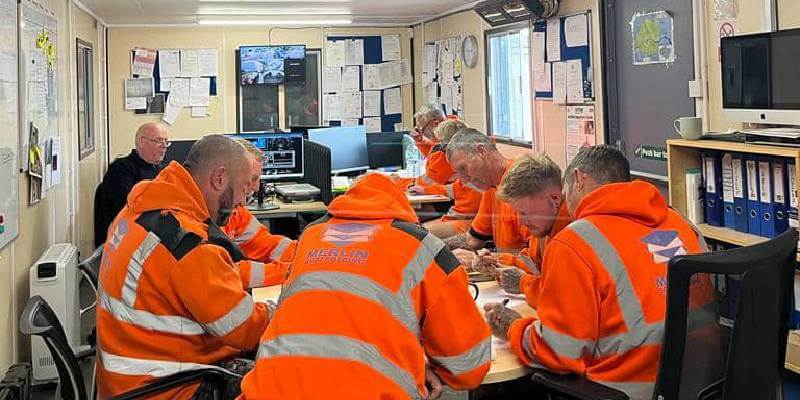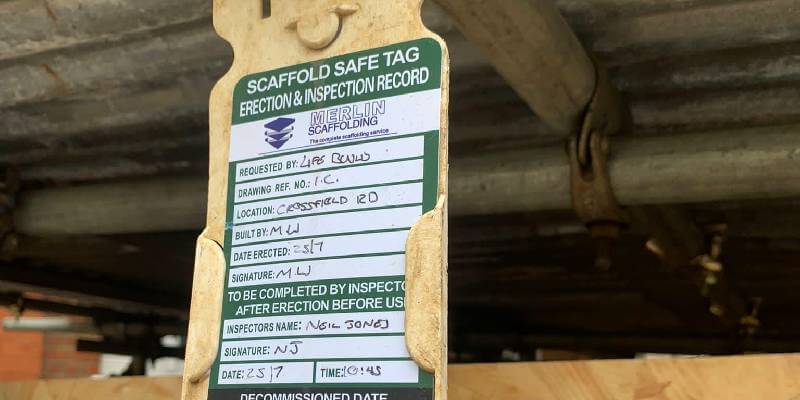Construction sites are some of the most dangerous workplaces in the country; many hazards can cause injuries or even fatalities, meaning that strict safety protocols are vital.
As a reputable scaffolding company in Northampton and the surrounding areas, we have worked on construction sites for over 20 years. With every project, we implement and follow strict health and safety processes, so we have pieced together an article with our top construction site safety tips.
A Guide To Construction Site Safety
As the premier scaffolding company in Northampton with an abundance of health and safety accreditations, we recognise the dangers associated with working on a construction site. Our team of dedicated scaffolders are thoroughly trained and meticulously vetted to undertake work in hazardous environments, maintaining a professional and serious manner at all times. Drawing upon our extensive experience, we have curated a guide to share our expertise with those seeking a deeper understanding of staying secure on construction sites. Explore our guide and educate yourself to navigate construction sites safely.
Looking for dedicated scaffolders for your project?
Contact us to book your FREE site survey!
Get StartedWho Is Responsible For Construction Site Safety?
All construction workers have the right not to get injured whilst on site or during the work they carry out; however, whilst on site, health and safety are ultimately the responsibility of everyone involved. Employers, employees, subcontractors, vendors, and regulatory bodies must all work together to ensure a safe work environment. The higher your role is in this list, the level of your responsibility increases, meaning that an employer or the main contractor has the most significant responsibility for the safety of everyone on the site.
Their responsibility extends to guaranteeing that everyone is appropriately trained and equipped with necessary safety gear and ensuring the ongoing project is conducted in an environment free from hazards or dangers. They must ensure the implementation of suitable and sufficient safety policies, coupled with regular risk assessments. In the face of identified risks, they must promptly take appropriate actions and inform their supervisor or employer. Some more of their responsibilities include:
- Provide inductions
- Control site access and site security
- Ensure contractors conform to health and safety
- Consider health and safety when scheduling work
- Ensure everyone follows the construction phase plan
- Ensure welfare facilities are provided
- Monitor the work
- Consult and engage with workers
Nevertheless, it is crucial for employees, subcontractors, and vendors also to understand their roles and responsibilities to actively participate in maintaining a risk-free environment. Their essential part involves strict adherence to all safety policies and regulations established on the construction site. This includes wearing appropriate safety equipment as required and promptly reporting any identified hazards to their employer or supervisor. By taking personal responsibility for their safety and that of their colleagues, these individuals contribute significantly to the overall success of the safety measures implemented on the construction site.
With a wealth of accreditations such as Acclaim Accreditation, CHAS and Avetta, our experts in scaffolding in Northampton understand that by staying up to date with safety regulations and understanding the responsibilities of everyone on-site, you actively contribute to creating a safer and more secure working environment. This commitment ensures that all team members can work in an environment where well-being is prioritised, promoting a positive and safe workplace.

Construction Site Health and Safety Tips
According to the Health and Safety Executive’s (HSE) statistics, the construction industry stands as the second most dangerous job, witnessing 53,000 non-fatal injuries over a three-year period and recording 45 fatalities in the year 2022/23. These figures showcase the critical importance of prioritising safety on construction sites.
Firstly, let’s run through the most common hazards and risks that are associated with construction sites:
- Falls from heights: This is the biggest cause of fatalities as this type of work occurs daily. It involves working on roofs and scaffolding.
- Falls, slips and trips: With appropriate practices put in place, this injury can be avoided. Usually, they are caused by slippery surfaces, debris and clutter.
- Hearing problems: There are over 21,000 UK construction workers with hearing problems caused by their jobs, so it is vital to wear appropriate PPE to limit this.
- Electrical hazards: People may be exposed to wiring, power lines or faulty equipment, causing electrocution, burns and shocks.
Luckily, due to being vetted by leading bodies such as Acclaim Accreditation, CHAS and Avetta, we understand that there are many ways to stay safe and secure whilst working on a construction site. As expert scaffolders in Northampton, to minimise risks, we have compiled our top tips to guide individuals while on site, ensuring they prioritise their safety and security throughout their shifts. These include:
1. Always Wear PPE
This serves as your ultimate safeguard in the face of potential danger; it protects you and ensures you are seen. Personal Protective Equipment (PPE) includes wearing a hi-vis jacket, safety boots, hard hats and occasionally safety goggles. It’s crucial to remember that while these objects are replaceable, the body they safeguard is not. Prioritising the consistent use of PPE safeguards your well-being and reinforces the understanding that protecting one’s health takes priority over the replaceable gear used for protection.
2. Follow Signs And Procedures
Think safely and check risk assessment and systems of work prior to starting any project. These control measures exist for a singular purpose: your safety. Deviating from appropriate plans and procedures puts you in harm’s way, highlighting the importance of being well-informed and up-to-date on the hazards in your surroundings.
3. Appropriate Training
Ensure that you have been thoroughly trained and briefed appropriately; it should never be assumed that training is not needed, even when it is just updating your knowledge. The training should cover using equipment, recognising hazards, emergency procedures and the right use of PPE.

4. Get Your Induction
It is essential to undergo a comprehensive induction before starting on any new project. This process guarantees that you have a clear understanding of on-site operations at all times, enabling you to carry out your responsibilities properly. By providing insight into potential hazards, safety procedures, and emergency protocols, the induction ensures that you are well-equipped to perform your job safely and contribute to a secure working environment.
5. Remain Tidy
It should be common sense that the more mess and clutter there is in any environment, the more hazards are in your way. This is amplified on a construction site as the hazards placed in your way can be fatal or seriously harmful, meaning that it is vital that you remain as tidy as possible throughout your shift, clearing any mess as you work to keep hazards to a limit.
6. Do Not Enter Unsafe Areas
Never enter an area marked with a danger sign, or if you know about the dangers in that area, do not enter it. For instance, avoid entering unsupported trenches, refrain from working beneath hazardous operations like cranes, and never engage in tasks at heights without suitable fall prevention equipment. Always prioritise caution and compliance with established safety measures in these situations to avoid risks and safeguard your well-being.

7. Don’t Tamper
Tampering with or trying to fix any equipment when you are not competent enough to do so is immediately putting yourself in harm’s way. You may not know of the dangers of the equipment you are working with and, therefore, are unknowledgeable about what could happen. For instance, never remove any scaffold ties or guards and tamper with gear or tools that may be faulty.
8. Report Problems
If you ever notice a problem or broken machinery or equipment, immediately inform your supervisor or employer. Taking swift action in reporting problems is crucial for preventing future issues and hazards, contributing to the overall safety of the work environment for you and your colleagues.
Our team of experts place rigorous protocols and regulations in place on our work sites to ensure the complete safety of all of our team and clients, and we understand that by following this proactive approach and implementing these measures, even those who are less knowledgeable about construction site safety can benefit. It provides a structured and accessible framework, ensuring that everyone understands and adheres to essential safety practices, effectively maintaining a safe work environment and thereby minimising the risk of accidents and injuries on the construction site.

Remaining Safe And Secure
As specialists in scaffolding in Northampton, we have acquired the necessary training and knowledge needed to work on a hazardous construction site. Our shared insights aim to equip you to navigate these challenges professionally and wisely, reducing the risks of injury or accidents. If you need extra information or have any more enquiries, feel free to get in touch with us today! To find out more about our line of work: scaffolding, take a look at our previous article!
